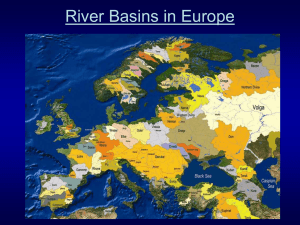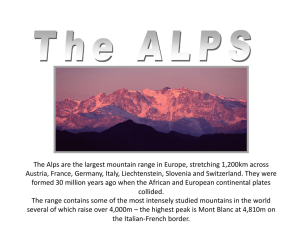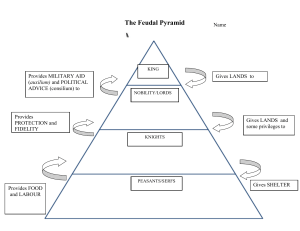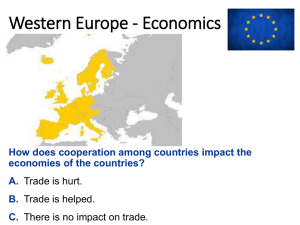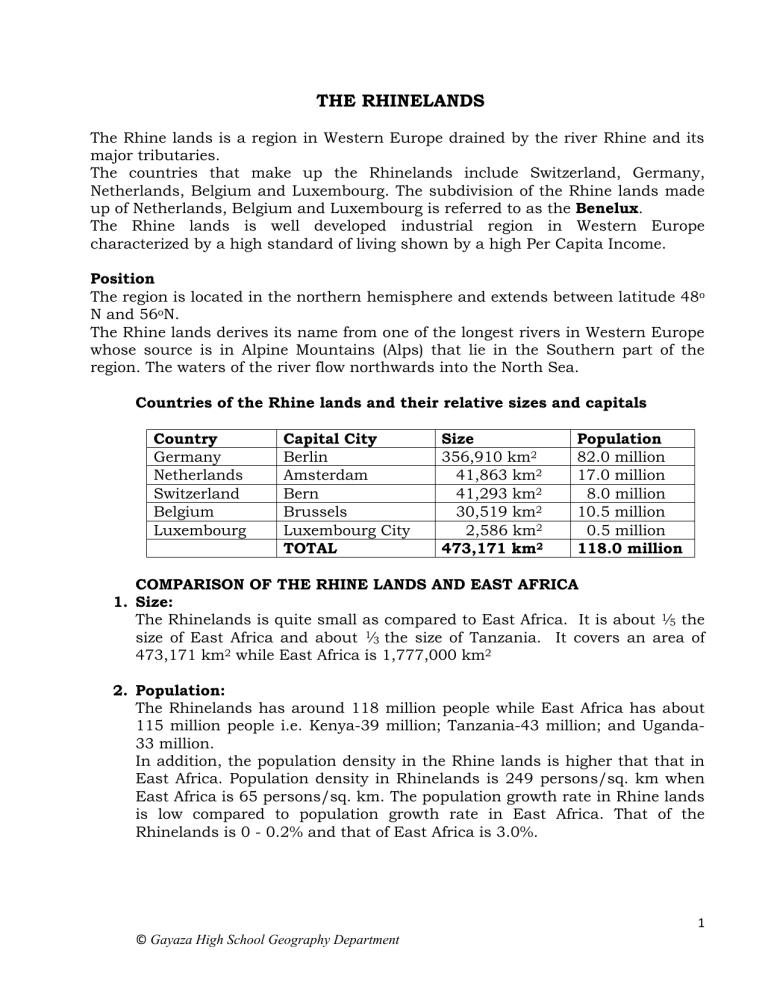
THE RHINELANDS The Rhine lands is a region in Western Europe drained by the river Rhine and its major tributaries. The countries that make up the Rhinelands include Switzerland, Germany, Netherlands, Belgium and Luxembourg. The subdivision of the Rhine lands made up of Netherlands, Belgium and Luxembourg is referred to as the Benelux. The Rhine lands is well developed industrial region in Western Europe characterized by a high standard of living shown by a high Per Capita Income. Position The region is located in the northern hemisphere and extends between latitude 48o N and 56oN. The Rhine lands derives its name from one of the longest rivers in Western Europe whose source is in Alpine Mountains (Alps) that lie in the Southern part of the region. The waters of the river flow northwards into the North Sea. Countries of the Rhine lands and their relative sizes and capitals Country Germany Netherlands Switzerland Belgium Luxembourg Capital City Berlin Amsterdam Bern Brussels Luxembourg City TOTAL Size 356,910 km2 41,863 km2 41,293 km2 30,519 km2 2,586 km2 473,171 km2 Population 82.0 million 17.0 million 8.0 million 10.5 million 0.5 million 118.0 million COMPARISON OF THE RHINE LANDS AND EAST AFRICA 1. Size: The Rhinelands is quite small as compared to East Africa. It is about 1⁄5 the size of East Africa and about 1⁄3 the size of Tanzania. It covers an area of 473,171 km2 while East Africa is 1,777,000 km2 2. Population: The Rhinelands has around 118 million people while East Africa has about 115 million people i.e. Kenya-39 million; Tanzania-43 million; and Uganda33 million. In addition, the population density in the Rhine lands is higher that that in East Africa. Population density in Rhinelands is 249 persons/sq. km when East Africa is 65 persons/sq. km. The population growth rate in Rhine lands is low compared to population growth rate in East Africa. That of the Rhinelands is 0 - 0.2% and that of East Africa is 3.0%. 1 © Gayaza High School Geography Department 3. Climate: The Rhinelands has a temperate type of climate because of its latitudinal position i.e. lies in high latitudes. Some areas experience warm temperate while others cool temperate climate. Alpine region experiences montane or cold climatic conditions. In the Rhinelands temperatures are generally lower than those in East Africa and also four seasons are experienced i.e. winter, spring, summer and autumn. East Africa lies within the tropics and experiences moist tropical climate (or modified equatorial while others experience dry tropical climate). As compared to the Rhinelands, temperatures are high and the region experiences 2 seasons i.e. dry and wet season. 4. Relief: The Rhinelands is generally a highland region and more so in the south where we find the Alps. The major highland areas include the Alps which were formed as a result of folding. Many of these highlands were modified by glaciation. Much of the Northern part has lowlands some of which have been reclaimed from the sea and in Netherlands some lands lie below sea level. East Africa is generally a plateau; there are some highlands resulting from faulting and volcanicity. Some of the highlands have been modified by denudational processes like weathering and erosion, leading to residual hills such as Inselbergs or even peneplains. In East Africa glaciation is very limited to the peaks of mountains Kilimanjaro, Kenya and Rwenzori. Both East Africa and the Rhinelands have rift valleys resulted from faulting. There is Rhine Rift Valley and in East Africa there is the Western and Eastern Arm of the great African Rift Valley. 5. Altitude: Rhinelands is on a lower altitude than East Africa. Some lands in the Rhine lands are even below sea level. 6. Geology: Rhinelands is made of recently formed rocks. It has younger rocks influenced by glacial erosion and deposition. East Africa has old basement rocks especially in the plateau regions. East Africa also has volcanic rocks especially in the volcanic areas. 7. Natural vegetation: The vegetation in highland regions of the Rhinelands is temperate forest e.g. trees such as spruce, pines, firs etc. There are also deciduous species like oak and beech. There are also temperate grasslands or meadows that characterize the Rhinelands vegetation. 2 © Gayaza High School Geography Department In East Africa, it is mainly savannah grasslands and woodlands as well as tropical forests and semi-desert vegetation e.g. scrub, thicket and thorn bush. 8. Mineral resources: The Rhinelands has coal, gold, and some other mineral though in small quantities. Coal is mined in the Ruhr Coal fields of Germany and is a source of power. Coal is the original basis for industrial development in the region. East Africa lacks coal deposits except in southern Tanzania where exploitation has been hindered by transport problems to the market. East Africa has diamonds in Mwadui mines in Shinyanga; salt in Lake Katwe; Soda ash in Lake Magadi; gold in Karamoja; limestone in Bamburi Mombasa, Hima, Tororo, Nairobi and Dar-es-Salaam; Copper and cobalt in Kilembe – Western Uganda (They are mined co-currently); There are Iron ore, wolfram and Beryllium deposits in Kabale - Western Uganda. 9. Economic Activities: The Rhinelands specializes in manufacturing industry and tourism. There are both heavy and light industries. Other activities like forestry, agriculture, lumbering and mining. East Africa is mainly agricultural and other activities include forestry, fishing, mining, lumbering and tourism. 10. Transport and Communication: The Rhinelands has a highly developed road and railway transport. Water transport is also well developed. A number of rivers such as the Rhine, Rhone, Ticino, Aare, Danube have been used for navigation. There are also a number of canals used for navigation. East Africa lacks a well developed road and railway system. Major rivers are not navigable because several sections have rapids/cataracts, waterfalls, shallow channels, narrow sections and floating vegetation. Navigation in East Africa is mainly on major lakes e.g. Victoria, Albert, and Tanganyika etc. 11. Nationalities, Ethnicity and Languages: The Rhinelands has Germans, Swiss, Belgians, Dutch and Luxembourgers. People are of several ethnic grouping e.g. Slavs, Semites etc. Languages spoken include German, French, Flemish, Belgian, Dutch, Luxembourgish, English and Romansch. In East Africa nationalities are Ugandans, Kenyans and Tanzanians. There are ethnic groups such as Bantu, Nilotics, Nilo-hermites. The tribes include Bakiga, Kikuyu, Luo, Sukuma, Luya, Nyamwezi, Kamba, Taita, Gogo, Mijikenda, Kamba, Baganda etc. Languages spoken include English, Swahili, Luganda, Luo, Runyankole, Rukiga etc. 3 © Gayaza High School Geography Department A Sketch map of the Rhinelands region showing countries, drainage features and Major cities 4 © Gayaza High School Geography Department
